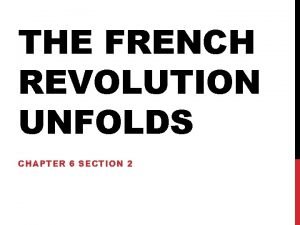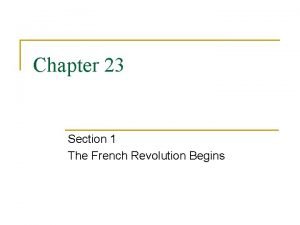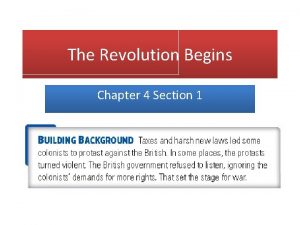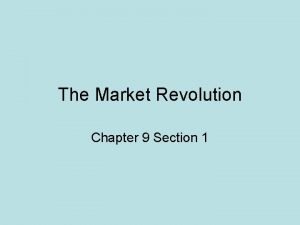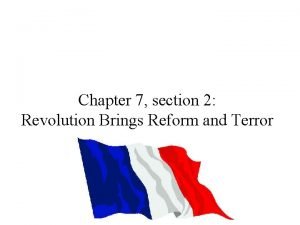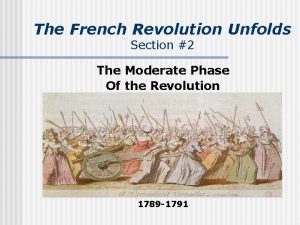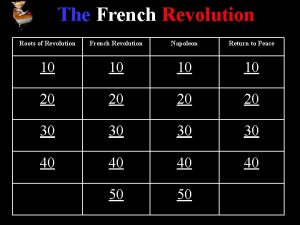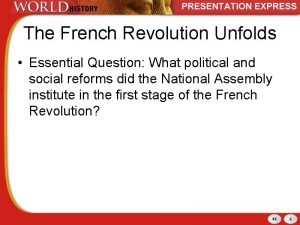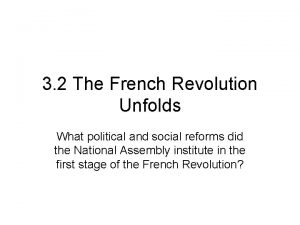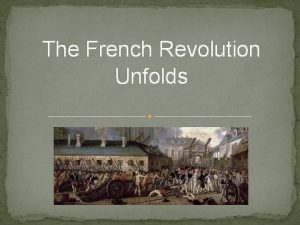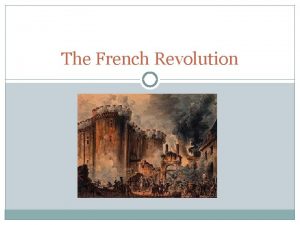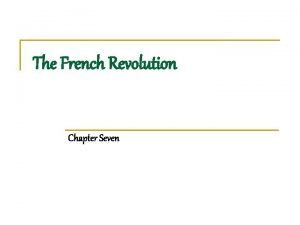Chapter 3 Section 2 French Revolution Unfolds Phases



















- Slides: 19

Chapter 3 Section 2 French Revolution Unfolds

Phases of Revolution 1789 -1791 Moderate Phase (National Assembly) 1792 -1794 Radical Phase (end of monarchy and Reign of Terror) 1795 -1799 Directory 1799 -1815 Age of Napoleon

Moderate Phase:

French Revolution Unfolds Paris divides into competing FACTIONS Moderates look to the Marquis de Lafeyette (who fought alongside George Washington) Was the head of the National Guard Middle Class militia organized in response to arrival of Royal troops First to wear the “tricolor”--blue, white, and red

Paris Commune--more radical group Replaced royal government in the city Newspapers and political clubs also sprouted up. Some even more radical.

Pg. 115 Standards Check

National Assembly Acts Nov 4 - Nobles in National Assembly agree to end their privileges (manorial dues, exclusive hunting rights, special legal status, tax exemptions)

Declaration of the Rights of Man (and the Citizen) Modeled in part from American Declaration of Independence Natural rights to “liberty, property, security, and resistance to oppression. ” All male citizens were equal before the law Freedom of Religion Taxed according to ability to pay

Liberty, Equality, Fraternity 1791 - Olympe de Gouges (journalist) writes Declaration of the Rights of Woman and the Female Citizen Later in revolution many women, including Gouges, executed for expressing their views

Women march on Versailles Oct 5, 1789 - 6, 000 women march 13 miles in the rain to Versailles demanding “Bread” and that the king return to Paris Angry with Marie Antoinette (queen) who lived in extravagance Royal family escorted back to Paris by the angry mob where they were virtual prisoners for the next 3 years.

National Assembly Presses Forward To pay off huge national debt the Assembly voted to take over and sell Church lands. Put the French Catholic Church under state control 1790 - Civil Constitution of the Clergy Bishops and priests became elected salaried officials Ended papal authority Dissolved convents and monasteries

Widens gulf between revolutionaries in Paris and peasantry in the provinces

Constitution of 1791 Creates a limited monarchy Creates a new Legislative Assembly Make laws Collect taxes Created equality before the law Ended Church interference

118 - Standards Check

Louis tries to escape Is recognized and captured a few miles from Austrian border Is seen as a traitor to the revolution

Rulers fear spread of Revolution Call revolutionary ideas and violence “the French plague” Fear is spread by EMIGRES

Declaration of Pilnitz August 1791 - King of Prussia and emperor of Austria (Marie Antoinette’s brother) threatened to intervene to protect French monarchy. France prepared for war

Radicals take over Sans-Culottes, working class revolutionary group, demand a republic Found support in the new Legislative Assembly among the Jacobins--revolutionary political club made of lawyers and intellectuals Eager to spread revolution and defeat tyranny abroad, radical groups take over and the Assembly declares war on Austria then Prussia and other European states.

Pg 120 (1 -2)
 Chapter 6 section 2 the french revolution unfolds
Chapter 6 section 2 the french revolution unfolds The french revolution unfolds
The french revolution unfolds 4 phases of french revolution
4 phases of french revolution Immediate cause of french revolution
Immediate cause of french revolution Chapter 7 section 1 the french revolution begins
Chapter 7 section 1 the french revolution begins The french revolution begins chapter 23 section 1
The french revolution begins chapter 23 section 1 Russian revolution vs french revolution
Russian revolution vs french revolution Economic causes of french revolution
Economic causes of french revolution The french revolution and napoleon section 1 quiz
The french revolution and napoleon section 1 quiz Chapter 11 the french revolution and napoleon
Chapter 11 the french revolution and napoleon Chapter 23 the french revolution and napoleon
Chapter 23 the french revolution and napoleon Chapter 11 the french revolution and napoleon
Chapter 11 the french revolution and napoleon The scientific revolution chapter 6 section 1
The scientific revolution chapter 6 section 1 The american revolution chapter 6 section 4
The american revolution chapter 6 section 4 Red “liberty caps and tricolor”
Red “liberty caps and tricolor” May 1775
May 1775 Chapter 9 section 1 the market revolution
Chapter 9 section 1 the market revolution Chapter 6 section 4 the american revolution
Chapter 6 section 4 the american revolution Chapter 7 section 2 revolution brings reform and terror
Chapter 7 section 2 revolution brings reform and terror Chapter 23 section 2 revolution brings reform and terror
Chapter 23 section 2 revolution brings reform and terror
